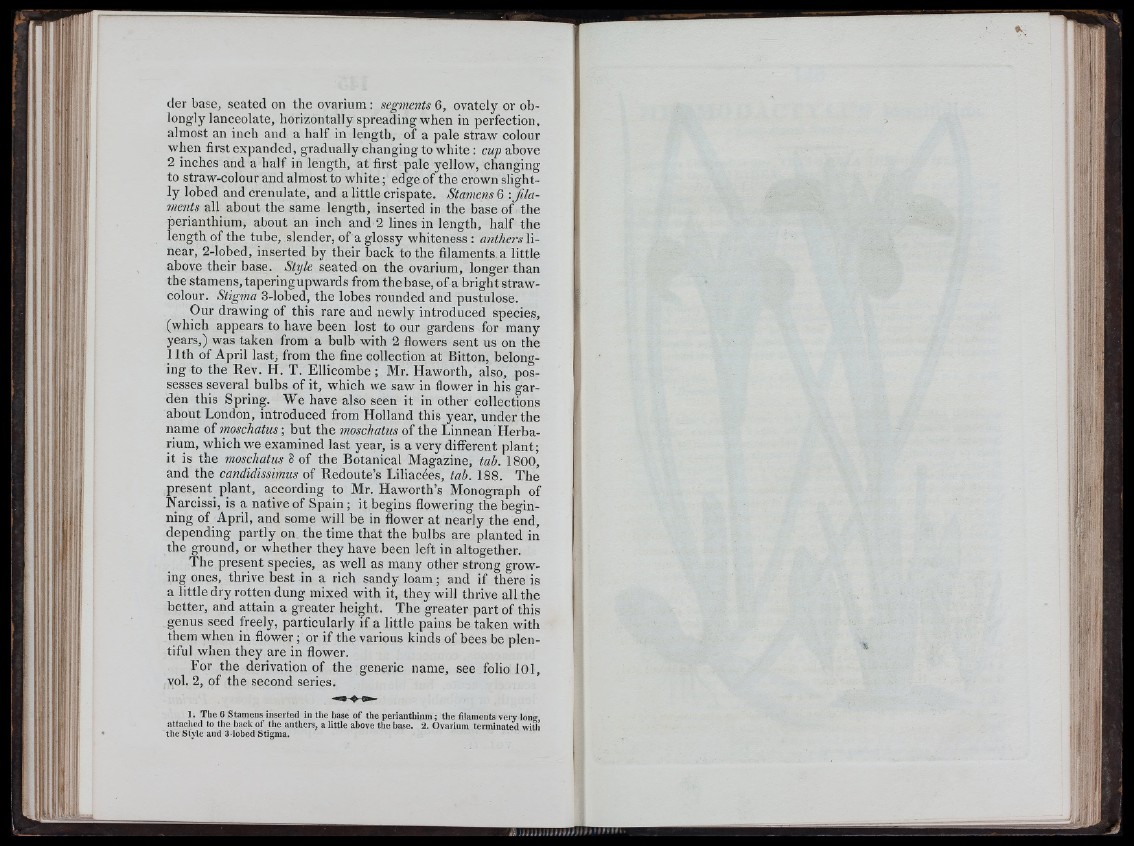
der base, seated on the ovarium: segments 6, ovately or oblongly
lanceolate, horizontally spreading when in perfection,
almost an inch and a half in length, of a pale straw colour
when first expanded, gradually changing to white : cup above
2 inches and a half in length, at first pale yellow, changing
to straw-colour and almost to white; edge of the crown slightly
lobed and crenulate, and a little crispate. Stamens 6 -.Jilaments
all about the same length, inserted in the base of the
rerianthium, about an inch and 2 lines in length, half the
ength of the tube, slender, of a glossy whiteness : anthers linear,
2-lobed, inserted by their back to the filaments a little
above their base. Style seated on the ovarium, longer than
the stamens, taperingupwards from thebase, of a bright straw-
colour. Stigma 3-lobed, the lobes rounded and pustulose.
Our drawing of this rare and newly introduced species,
(which appears to have been lost to our gardens for many
years,) was taken from a bulb with 2 flowers sent us on the
11th of April last, from the fine collection at Bitton, belonging
to the Rev. H. T. Ellicombe ; Mr. Haworth, also, possesses
several bulbs of it, which we saw in flower in his garden
this Spring. We have also seen it in other collections
about London, introduced from Holland this year, under the
name of moschatus-, but the moschatus of the Linnean Herbarium,
which we examined last year, is a very diflerent plant;
it is the m o sch a tu s0Í the Botanical Magazine, tab. 1800,
and the candidissimus of Redoute’s Liliacées, tab. 188. The
present plant, according to Mr. Haworth’s Monograph of
Narcissi, is a native of Spain ; it begins flowering the beginning
of April, and some will be in flower at nearly the end,
depending partly on the time that the bulbs are planted in
the ground, or whether they have been left in altogether.
The present species, as well as many other strong growing
ones, thrive best in a rich sandy loam; and if there is
a little dry rotten dung mixed with it, they will thrive all the
better, and attain a greater height. The greater part of this
genus seed freely, particularly if a little pains be taken with
them when in flower; or if the various kinds of bees be plentiful
when they are in flower.
For the derivation of the generic name, see folio lOl,
vol. 2, of the second series.
1. Th e G Stamens inserted in the base o f the perian thium; the filaments v ery long
attached to tlie back o f the anthers, a little above the base. 2. Ovarium terminated with
th e S ty le and 3-lobed Stignia.
nr
tl
' m
E J i m